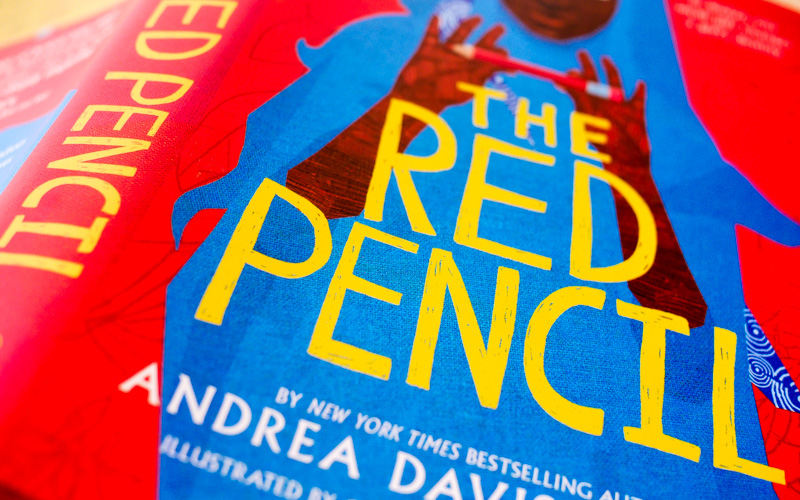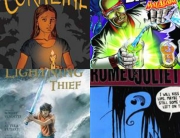Grades 4-12, Level Q, Lexile HL620 ![]()
Click on the TR button for free Teacher Resources with this title.
On the heels of reading Brown Girl Dreaming, which rekindled my love affair with poetry and sparked a brand new obsession with novels in verse, I found Andrea Davis Pinkney’s post “Finding the Red Pencil” over at Nerdy Book Club and knew immediately that The Red Pencil had to be my next book. In that post, Pinkney writes that Amira, the 12-year-old Sudanese girl at the heart of The Red Pencil, called to her in a dream to write Amira’s story. And with as much beauty and hope as war and destruction can bring, Pinkney does tell Amira’s story, the story of many Sudanese children during the Darfur genocide of 2003.
The Red Pencil: Fiction Grounded in Research
While The Red Pencil is a work of fiction, the text is deeply grounded in research making this book a great text to pair with social studies,  geography or history projects to extend learning beyond the scope of the book’s pages (CCRA.R.8, CCRA.R.9). But it really is within the pages where this book’s beauty lies. Short, yet moving poems convey the messages of family, hope, war, destruction, determination, art, beauty and flight. These concise words, structured in verse and accompanied by Shane W. Evans’s pencil sketches, bring to life Amira’s thoughts in first-person narration. The images appear to the reader as if Amira herself drew them with, first, her “turning-twelve twig,” a gift from her father she uses to express herself through art. And then eventually, the images are created with the red pencil that symbolizes her true voice and spirit lost in the tragedy of war, but found again.
geography or history projects to extend learning beyond the scope of the book’s pages (CCRA.R.8, CCRA.R.9). But it really is within the pages where this book’s beauty lies. Short, yet moving poems convey the messages of family, hope, war, destruction, determination, art, beauty and flight. These concise words, structured in verse and accompanied by Shane W. Evans’s pencil sketches, bring to life Amira’s thoughts in first-person narration. The images appear to the reader as if Amira herself drew them with, first, her “turning-twelve twig,” a gift from her father she uses to express herself through art. And then eventually, the images are created with the red pencil that symbolizes her true voice and spirit lost in the tragedy of war, but found again.
Because this story is told through the eyes of a child, it is deceptively simple and written to reach readers at all levels. The complexities presented are done so in a way to teach young readers about the realities of war-torn countries while also shielding them from grotesque details. Because poetry is about precision of language, the details are written in the spaces between each delicately chosen word. Using this text as a read aloud, teachers can discuss the importance of word choice and students can analyze how each word shapes the tone and meaning of each poem and the story as a whole (CCRA.R.4).
Another beauty of this text is that while it is a complete novel with poems written in chronological order to tell Amira’s story, each poem also has its own legs to stand on, just as Amira stands on her own two legs in the final poem “Flight” (CCRA.R.5). For a writing activity, students could choose a poem from the book and write about what that poem represents in the story and how, if read alone, it might take on its own meaning for the reader. “Hand, Twig, Sparrow” is that poem for me, for
I never know
what my hand
and my twig
and my sparrow
will create.
My hand holds my twig.
But my twig goes on its own.
My sparrow—that’s what’s inside me:
Flight.
Words have moved me my whole life, and with each novel in verse I read I cannot help but feel the impact of language in my bones. The Red Pencil is no different. Read this to your students, let them discover the rich beauty of words and the haunting realities of life around the world. Encourage them to find the right words to tell their own stories of joy, happiness, struggle or hardship. Even a free writing word association activity can create a beautiful visual poem without them even realizing what they are doing. Creative and critical thinking has the ability to appear in sneaky ways!
Because novels in verse have become my new passion, I’m always looking for new great titles to read. Please comment below with your poetry recommendations!





Leave A Comment